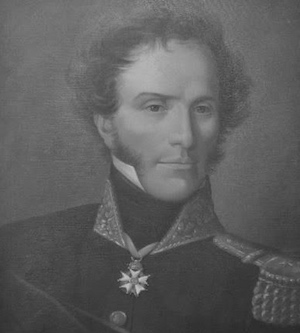General François Antoine Teste

Born: November 19, 1775
Place of Birth: Bagnols-sur-Cèze, Gard, France
Died: December 8, 1862
Place of Death: Angoulême, France
Arc de Triomphe: TESTE on the north pillar
The son of a lawyer, François Antoine Teste entered the army as a grenadier in the National Guard of the department of Gard in August of 1792. In April of 1793 he saw action when he marched against the rebels of the camp of Jalès and that September he was elected lieutenant colonel of the 1st Battalion of Requisition of the district of Pont-Saint-Esprit. Sent to the Army of the Eastern Pyrenees, in May of 1794 Teste was suspended by the representatives of the people due to his alleged lack of ability. In September of 1798 he was reintegrated into the army as a chef de bataillon and then he served in the Army of the Danube, the Army of Switzerland, and the Army of Italy. In November of 1799 Teste became an aide-de-camp to General Chabran and only a few months later he became chief of staff to Chabran. He next joined the Army of the Reserve and he served at the siege of Fort Bard in May. In August of 1800 Teste was promoted to chef de brigade of the 5th of the Line and in the following years he served in Italy.
As war broke out in 1805, Teste was still serving in Italy. That September he joined Molitor's 3rd Division and in October he distinguished himself at the crossing of the Adige and then at the combat of San Pietro-in-Gu. Marshal Masséna promoted Teste to général de brigade on the battlefield. In April of 1806 Teste was sent to Dalmatia in charge of the 5th and the 23rd of the Line where he occupied and defended Ragusa. In 1807 he commanded a variety of positions first at Spalato, then Brescia, Verona, and Treviso. Teste continued to serve in Italy and in 1809 during the War of the Fifth Coalition he took part in the Italian campaign against Austrian forces by commanding the 1st Brigade of Grenier's 3rd Division. That April he fought at Sacile where his foot was shattered by grapeshot, but he recovered enough to serve at Raab in June. In 1810 Teste was named a Baron of the Empire but he was also put on leave.
In 1811 Teste took command of the 2nd Brigade of Compans' Division in the Corps of Observation of the Elbe. However, that year he spent much of his time as governor of Custrin. For the Russian campaign of 1812, Teste resumed command of his brigade and shortly before the Battle of Borodino he fought at the action of the redoubt of Schwardino. Two days later he fought at the Battle of Borodino where he was grievously wounded by a shot to the right arm. Teste was sent back to command Wiazma and he then returned to France. In 1813 he was promoted to général de division and he took command of the 4th Division of VI Corps. He went on to rescue the city of Cassel from cossacks and then he became governor of Magdeburg. In July of 1813 Teste's division joined General Vandamme's I Corps and in August he fought at the Battle of Kulm where he was taken prisoner.
After Napoleon's abdication and the Bourbon Restoration in 1814, Teste was released to return to France. The Bourbons named him a Knight of Saint Louis and commander of the department of Pas-de-Calais. Nevertheless, when Napoleon returned to France and resumed power in 1815, Teste accepted a command in the Army of the North. He commanded the 21st Infantry Division of VI Corps and served in Belgium. On June 17th Teste's division was detached from VI Corps and placed under the orders of Marshal Grouchy on the right wing to help in the pursuit of the Prussians. Therefore Teste served at the Battle of Wavre on the 18th and then at the mill of Bierges on the 19th. On the 20th he covered Grouchy's retreat and he distinguished himself repulsing the pursuing Prussians at Namur. Later Marshal Davout the Minister of War ordered Teste and his division to the left bank of the Loire, and after the Second Restoration Teste was put on non-activity. Teste's brother Jean Baptiste Teste was a prominent minister in the government of King Louis Philippe.
Bibliography
- Divry, Arnauld. Les Noms Gravés sur l'Arc de Triomphe. Paris: L'Harmattan, 2017.
- Six, Georges. Dictionnaire Biographique des Généraux & Amiraux Français de la Révolution et de l'Empire (1792-1814). 2 vols. Paris: Gaston Saffroy, 2003.
Updated September 2019
© Nathan D. Jensen